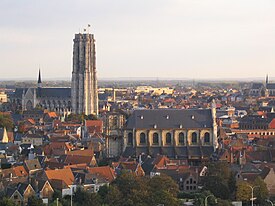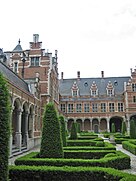
Back Mechelen Afrikaans مشلين Arabic ميشيلين ARZ Мехелен Byelorussian Мэхэлен BE-X-OLD Мехелен Bulgarian Mechelen Breton Malines Catalan Mechelen (parokya) CEB Mechelen Czech
Mechelen
Malines (French) | |
|---|---|
Left to right, top to bottom: View of the city with St. Rumbold's Cathedral on the far left, Grote Markt with Mechelen City Hall, Brusselpoort, Hof van Savoye, IJzerenleen in the city center with the Schepenhuis | |
Location in Belgium
| |
| Coordinates: 51°01′40″N 4°28′50″E / 51.02778°N 4.48056°E | |
| Country | |
| Community | Flemish Community |
| Region | Flemish Region |
| Province | Antwerp |
| Arrondissement | Mechelen |
| Government | |
| • Mayor | Bart Somers (Open VLD) |
| • Governing party/ies | Open VLD-Groen-M+ |
| Area | |
| • Total | 65.79 km2 (25.40 sq mi) |
| Population (2020-01-01)[1] | |
| • Total | 86,921 |
| • Density | 1,300/km2 (3,400/sq mi) |
| Postal codes | 2800, 2801, 2811, 2812 |
| NIS code | 12025 |
| Area codes | 015–03 |
| Website | www |
Mechelen (Dutch pronunciation: [ˈmɛxələ(n)] ⓘ; French: Malines [malin]; historically known as Mechlin in English[n 1]) is a city and municipality in the province of Antwerp in the Flemish Region of Belgium. The municipality comprises the city of Mechelen proper, some quarters at its outskirts, the hamlets of Nekkerspoel (adjacent) and Battel (a few kilometers away), as well as the villages of Walem, Heffen, Leest, Hombeek, and Muizen. The river Dyle (Dijle) flows through the city, hence it is often referred to as the Dijlestad ("City on the Dyle").
Mechelen lies on the major urban and industrial axis Brussels–Antwerp, about 25 km (16 mi) from each city. Inhabitants find employment at Mechelen's southern industrial and northern office estates, as well as at offices or industry near the capital and Brussels Airport, or at industrial plants near Antwerp's seaport.
Mechelen is one of Flanders' prominent cities of historical art, with Antwerp, Bruges, Brussels, Ghent, and Leuven. It was notably a centre for artistic production during the Northern Renaissance, when painters, printmakers, illuminators and composers of polyphony were attracted by patrons such as Margaret of York, Margaret of Austria and Hieronymus van Busleyden.[2][3][4]
- ^ "Bevolking per gemeente op 1 januari 2020". Statbel.
- ^ Annual review 2007 Flemish Foreign Affairs - see 13. The art cities action plan (PDF), Flemish Department of Foreign Affairs - Departement Internationaal Vlaanderen, May 2008, p. 22, retrieved 31 October 2012[permanent dead link]
- ^ Tourism in Flanders (PDF), Flemish Department of Foreign Affairs, 10 April 2008, retrieved 19 October 2009,
In terms of international tourism, the emphasis lies on six magnificent historic and geographically concentrated cities of art: Brussels, Antwerpen, Brugge, Gent, Leuven and Mechelen
[dead link] - ^ Ontwerp van decreet houdende het Vlaams cultureel-erfgoedbeleid - stuk 1588 (2011-2012) – Nr. 1 ingediend op 2 mei 2012 (2011–2012) (PDF) (in Dutch), Flemish Parliament, 2012, pp. 4–5, retrieved 31 October 2012,
The five so-called art cities having a high density of cultural heritage across all types of work (Antwerp, Ghent, Bruges, Leuven and Mechelen) ... these cities have a long tradition in developing and substantiating a local cultural heritage.
(quote translated)
Cite error: There are <ref group=n> tags on this page, but the references will not show without a {{reflist|group=n}} template (see the help page).
© MMXXIII Rich X Search. We shall prevail. All rights reserved. Rich X Search









